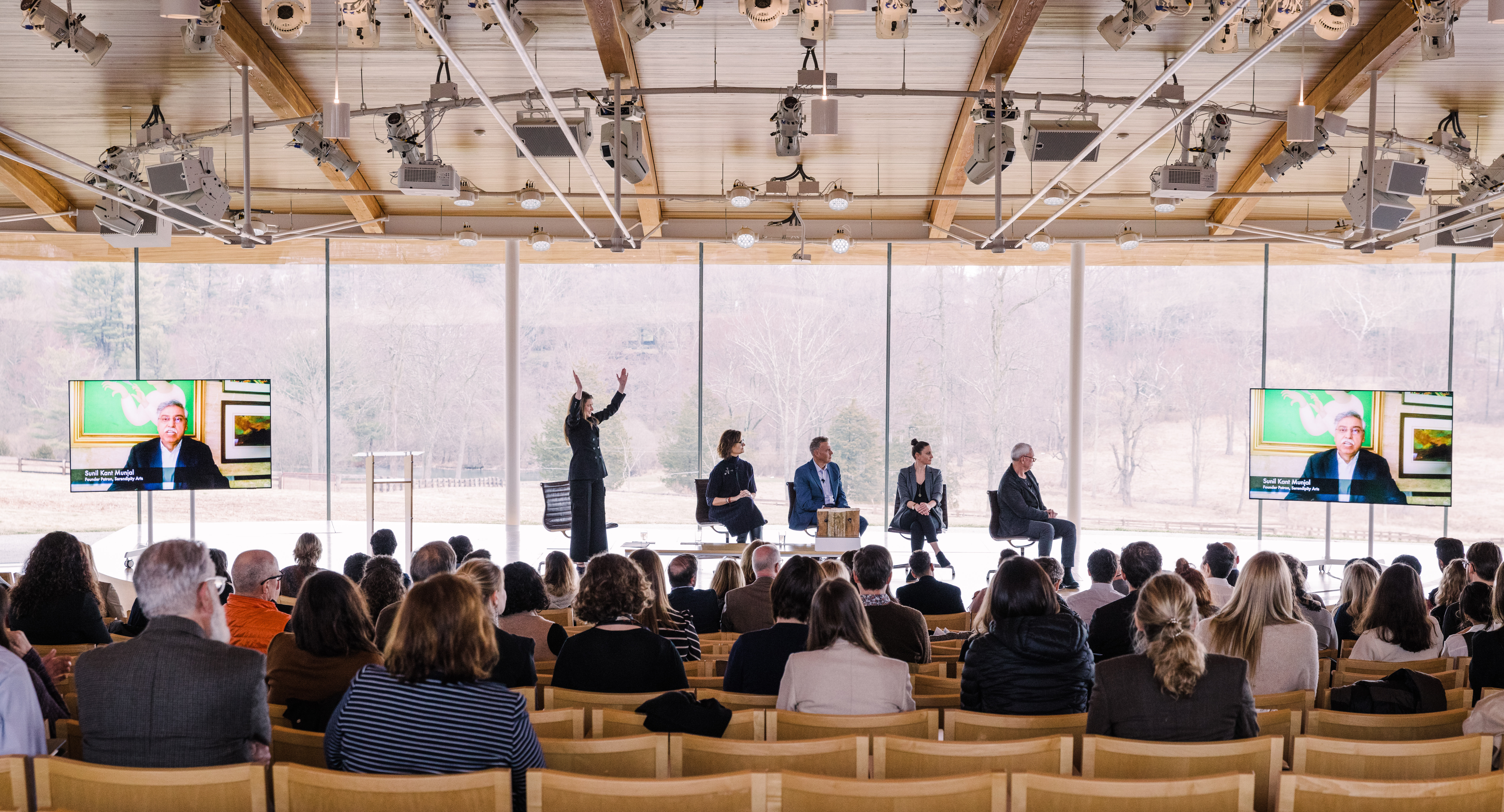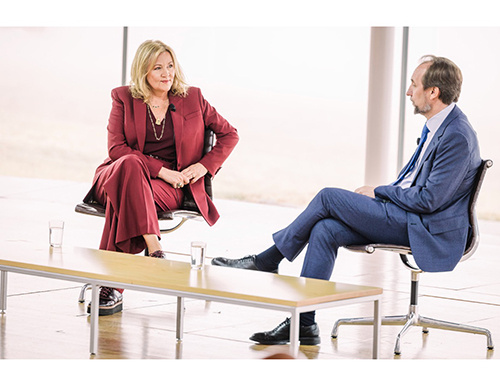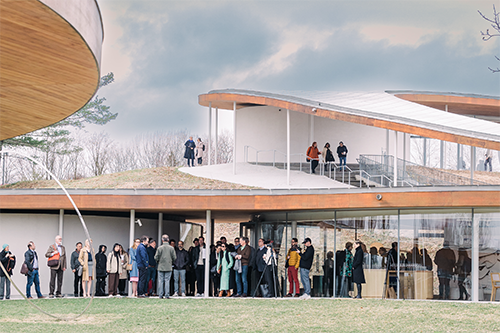Design for Freedom by Grace Farms Convened Leaders in the Built Environment for Inaugural Summit
New Center for Arts and Culture in New Delhi, India will be the First Design for Freedom Pilot Project in Asia
New Design for Freedom Toolkit Will Offer
Comprehensive Resource for Design and Construction Professionals

The newest Design for Freedom Pilot Project was announced during a panel moderated by Grace Farms Foundation’s Creative Director and Chief Advancement Officer Chelsea Thatcher.
On March 31, Design for Freedom by Grace Farms held the inaugural Design for Freedom Summit, bringing together more than 275 leaders of the built environment for a day of awareness and action in response to the humanitarian issue of forced labor in the building materials supply chains.

Prince Zeid Ra’ad Al Hussein, CEO of International Peace Institute, and Sharon Prince, CEO and Founder of Grace Farms Foundation give the keynote address. Photo credit: Jacek Dolata
At the Summit, Sharon Prince, CEO and Founder of Grace Farms Foundation said, “We need to encourage capitalism that works for all. Economic growth cannot be at the expense of the most vulnerable. By bringing together leaders in the built environment, we will work together to create true market transformation and build a more equitable future.”
“All good revolutions begin like this,” said Prince Zeid Ra’ad al Hussein, President and CEO of the International Peace Institute at the Design for Freedom Summit. “We need to address forced labor through the sourcing of materials … the way that you are doing this is really amazing because no one else has thought of it.”
During the Summit, Grace Farms Foundation and Serendipity Arts announced the first Design for Freedom Pilot Project in Asia. Located in New Delhi, India, this new center for arts and culture will be designed for accessibility, inclusion, sustainability, fairness, and as a welcoming place to all.
“I want to compliment Sharon Prince and Grace Farms for setting up this Summit. In the arts and cultural center that Serendipity Arts is setting up in New Delhi, we are hoping to make this a model project, and we are delighted to partner with Grace Farms to turn this into a Design for Freedom Project,” said Sunil Kant Munjal, Founder Patron of Serendipity Arts.
The new Pilot Project was announced during a panel moderated by Grace Farms Foundation’s Creative Director and Chief Advancement Officer Chelsea Thatcher. Ms. Thatcher has been instrumental in securing major U.S. and international Design for Freedom Pilot Projects.
Grace Farms previously announced four Design for Freedom Pilot Projects in the U.S. and abroad that include the 21st Serpentine Pavilion Black Chapel designed by Theaster Gates, Shadow of a Face, a monument of Harriet Tubman by Nina Cooke John, the New Canaan Library, and Temporal Shift, a sculpture by Alyson Shotz.

Joe Mizzi of Sciame Construction discusses Temporal Shift as a Design for Freedom Pilot Project. Photo credit: Jacek Dolata
Major construction industry representatives also presented at the Summit, including Angel Dizon and Christine Foushee from the U.S. Department of State’s Bureau of Overseas Building (OBO) and Lynn Temple from Turner Construction, which is working on a Design for Freedom Pilot Project.
Not only was looking at the current state of the building materials supply chain a focus of the Summit, but so was looking toward the future. Chris Sharples of SHoP Architects and Anna Dyson from the Yale Center for Ecosystems in Architecture gave an interactive tech talk on the future of the AEC industry, noting how technology can be used in design, construction, and manufacturing to help reduce the risk of forced labor in building materials.
In addition to the panels, industry leaders also spoke at roundtable discussions on a wide range of topics, including interiors as an entry point for Design for Freedom principles and gaining visibility into supply chains, which was co-led by Debbie Propst, President, Global Retail, MillerKnoll; and a materials study of timber and other at-risk building materials led by Michael Green of Michael Green Architecture and Patricia Saldaña Natke of UrbanWorks.
Design for Freedom by Grace Farms also released the Design for Freedom Toolkit, a new, comprehensive resource that design and construction professionals can use to help implement ethical, forced labor-free material sourcing strategies into their own practices. The toolkit contains information on more than a dozen materials, such as timber, steel, and rubber, that are most at-risk of forced labor, as well as relevant certifications and standards that support ethical materials choices, a supplier questionnaire, and sample specifications. The digital toolkit can be downloaded at the Design for Freedom website.
“Design and construction professionals have been eager to incorporate Design for Freedom into their projects but have been uncertain about how best to get started,” said Nora Rizzo, Sustainable Materials Director at Grace Farms Foundation. “The Design for Freedom Toolkit provides an entry point to initiate the conversation and execute Design for Freedom Principles.”
In addition to experts in the architecture, engineering, and construction industries, the Summit was attended by university students. Students from the University of Hartford attended with Professor Michael J. Crosbie, who was recognized this year by the American Institute of Architects as a Distinguished Professor. Students from Yale were at the Summit alongside Yale’s School of Architecture Associate Dean Phil Bernstein, who also led a roundtable discussion. Professor Susan Davis from New York University attended with her class and in an impromptu and poignant moment recited A Woman’s Creed, a piece written by a group of women for the 1994 WEDO Global Strategies Meeting and featured in Grace Farms’ Peace Forest exhibit.
Throughout the day, Summit participants also had the opportunity to explore Grace Farms, taking nature walks, experiencing tea in the Pavilion, and enjoying two exhibitions — Common Good Through Crisis, designed by 2022 AIA Firm of the Year MASS Design, and Peace Forest, by Peter Miller of Palette Architecture and Shohei Yoshida of sy + a, both project architects on Grace Farms’ River building.
Since the release of the Design for Freedom report in October 2020, Grace Farms has collaborated with more than a dozen colleges and universities nationally and internationally to present Design for Freedom and educate future leaders.
Forced labor and human trafficking is an estimated $150 billion industry. The illegal use of forced labor across industrial sectors subsidizes corporate profits and has contributed to the expansion of this global industry. This criminal activity affects approximately 25 million people, mostly from impoverished communities or from areas of conflict and disasters. Design for Freedom seeks to address this pressing humanitarian crisis by creating a radical paradigm shift to design and build a more humane future.
Feature photo credit: Jacek Dolata